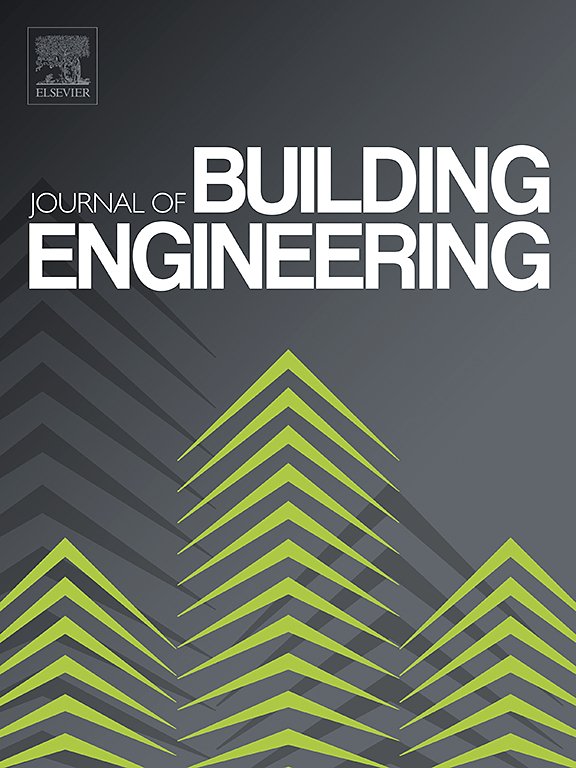评估混合软木和硬木交叉层压木材的弯曲和剪切性能
IF 6.7
2区 工程技术
Q1 CONSTRUCTION & BUILDING TECHNOLOGY
引用次数: 0
摘要
当前版本的 PRG-320(CLT)规定了 CLT 的制造和设计,限制了软木树种的生产。因此,在未来十年内,对 CLT 生产不断增长的需求可能会使美国的软木木材供应紧张。将硬木与软木一起纳入 CLT 生产,可能是解决这一问题的潜在办法。本文研究了使用黄杨和南方松的不同组合制造的三层和五层混合树种 CLT 横梁的弯曲和剪切测试结果。对横梁的弯曲强度、弯曲刚度、剪切强度和剪切刚度进行了评估,并对含水率、比重、抗压缩剪切力和抗分层能力进行了质量控制测试。根据容许应力设计(ASD)进行调整以确保不超过应力限制后,所有 CLT 组的实验值均大于使用剪切类比法计算得出的值。唯一的例外是所有层数均为南方松的组别和外层为南方松内层为黄杨的组别(层数代码见表 1),其弯曲刚度值的差异保持在 4% 的微小范围内。不过,根据相应的标准,在抗压荷载剪切力方面,木材的破坏率低于 80% 的最大值,而在抗分层力方面,表面分层率则高于 5% 的最小值。所有 CLT 梁的机械性能都达到或超过了剪切类比值。测试结果表明,由于黄杨的比重与南方松相似,因此可以替代南方松生产 CLT。这表明,混合树种 CLT 可以保持或提高结构性能,同时解决材料短缺问题。此外,在 CLT 生产中使用黄杨可促进可持续林业实践,支持资源多样化,并鼓励建筑方法创新。这些发现对木材和建筑行业具有重要的现实意义,有助于提高成本效益和环境可持续性。本文章由计算机程序翻译,如有差异,请以英文原文为准。
Evaluation of bending and shear properties of mixed softwood & hardwood cross-laminated timbers
The current version of PRG-320 (CLT) that governs CLT manufacturing and design, limits production to softwood species. As a result, the growing demand for CLT production could strain the supply of softwood lumber in the US within the next decade. The inclusion of hardwood in CLT production alongside softwood could be a potential solution to this problem. This paper investigates the bending and shear test results of three- and five-layer mixed species CLT beams manufactured using various combinations of yellow-poplar and southern pine. The beams were evaluated for bending strength, bending stiffness, shear strength, and shear stiffness, as well as quality control testing of moisture content, specific gravity, resistance to shear by compression loading and resistance to delamination. The experimental values for all CLT groups, adjusted according to the Allowable Stress Design (ASD) to ensure stress limits are not exceeded, were greater than those calculated using the shear analogy method. The only exceptions were bending stiffness values for the groups with all layers of southern pine and those with outer layers of southern pine and inner layers of yellow-poplar (see Table 1 for layups codes), where the differences remained within a minor range of 4 %. Although, wood failure percentages in resistance to shear by compression loading fell below the maximum value of 80 %, and face delamination percentages in resistance to delamination were above the minimum value of 5 % according to the corresponding standards. The mechanical properties of all CLT beams met or exceeded shear analogy values. The test results indicated that yellow-poplar could be a viable alternative to southern pine in the production of CLT due to its similar specific gravity. This suggests that mixed-species CLT can maintain or enhance structural performance while addressing material shortages. Furthermore, the use of yellow-poplar in CLT production promotes sustainable forestry practices, supports resource diversification, and encourages innovation in construction methods. These findings have significant practical implications for the timber and construction industries, contributing to cost efficiency and environmental sustainability.
求助全文
通过发布文献求助,成功后即可免费获取论文全文。
去求助
来源期刊

Journal of building engineering
Engineering-Civil and Structural Engineering
CiteScore
10.00
自引率
12.50%
发文量
1901
审稿时长
35 days
期刊介绍:
The Journal of Building Engineering is an interdisciplinary journal that covers all aspects of science and technology concerned with the whole life cycle of the built environment; from the design phase through to construction, operation, performance, maintenance and its deterioration.
 求助内容:
求助内容: 应助结果提醒方式:
应助结果提醒方式:


